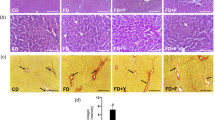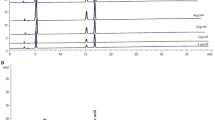Abstract
Purpose
The increased consumption of high-fructose corn syrup (HFCS) may contribute to the worldwide epidemic of fatty liver. In this study, we have investigated whether HFCS intake (20 % beverages) influences lipid synthesis and accumulation in conjunction with insulin receptor substrate-1/2 (IRS-1; IRS-2), endothelial nitric oxide synthase (eNOS), sirtuin 1 (SIRT1) and inducible NOS (iNOS) expressions in liver of rats. Resveratrol was tested for its potential efficacy on changes induced by HFCS.
Methods
Animals were randomly divided into four groups as control, resveratrol, HFCS and resveratrol plus HFCS (resveratrol + HFCS). HFCS was given as 20 % solutions in drinking water. Feeding of all rats was maintained by a standard diet that enriched with or without resveratrol for 12 weeks.
Results
Dietary HFCS increased triglyceride content and caused mild microvesicular steatosis in association with up-regulation of fatty acid synthase and sterol regulatory element binding protein (SREBP)-1c in liver of rats. Moreover, HFCS feeding impaired hepatic expression levels of IRS-1, eNOS and SIRT1 mRNA/proteins, but did not change iNOS level. Resveratrol promoted IRS, eNOS and SIRT1, whereas suppressed SREBP-1c expression in rats fed with HFCS.
Conclusions
Resveratrol supplementation considerably restored hepatic changes induced by HFCS. The improvement of hepatic insulin signaling and activation of SIRT1 by resveratrol may be associated with decreased triglyceride content and expression levels of the lipogenic genes of the liver.





Similar content being viewed by others
Abbreviations
- HFCS:
-
High-fructose corn syrup
- NAFLD:
-
Non-alcoholic fatty liver disease
- Res:
-
Resveratrol
- IRS-1; IRS-2:
-
Insulin receptor substrate-1/2
- eNOS:
-
Endothelial nitric oxide synthase
- SIRT1:
-
Sirtuin 1
- iNOS:
-
Inducible nitric oxide synthase
- FASN:
-
Fatty acid synthase
- SREBP:
-
Sterol regulatory element binding protein
- GAPDH:
-
Glyceraldehyde 3-phosphate dehydrogenase
- PI3K:
-
Phosphatidylinositol 3-kinase
- AST:
-
Aspartate aminotransferase
- ALT:
-
Alanine aminotransferase
- H&E:
-
Hematoxylin and eosin
- ORO:
-
Oil Red O
- TBST:
-
Tris buffer with NaCl–Tween
- HRP:
-
Horseradish peroxidase
References
Stanhope KL, Havel PJ (2010) Fructose consumption: recent results and their potential implications. Ann N Y Acad Sci 1190:15–24. doi:10.1111/j.1749-6632.2009.05266.x
Heiss SN (2013) “Healthy” discussions about risk: The corn refiners association’s strategic negotiation of authority in the debate over high fructose corn syrup. Public Underst Sci 22:219–235. doi:10.1177/0963662511402281
Collison KS, Saleh SM, Bakheet RH et al (2009) Diabetes of the liver: the link between nonalcoholic fatty liver disease and HFCS-55. Obesity (Silver Spring) 17:2003–2013. doi:10.1038/oby.2009.58
Bocarsly ME, Powell ES, Avena NM, Hoebel BG (2010) High-fructose corn syrup causes characteristics of obesity in rats: increased body weight, body fat and triglyceride levels. Pharmacol Biochem Behav 97:101–106. doi:10.1016/j.pbb.2010.02.012
Akar F, Uludağ O, Aydın A et al (2012) High-fructose corn syrup causes vascular dysfunction associated with metabolic disturbance in rats: protective effect of resveratrol. Food Chem Toxicol 50:2135–2141. doi:10.1016/j.fct.2012.03.061
Babacanoglu C, Yildirim N, Sadi G et al (2013) Resveratrol prevents high-fructose corn syrup-induced vascular insulin resistance and dysfunction in rats. Food Chem Toxicol 60:160–167. doi:10.1016/j.fct.2013.07.026
Postic C, Girard J (2008) Contribution of de novo fatty acid synthesis to hepatic steatosis and insulin resistance: lessons from genetically engineered mice. J Clin Invest 118:829–838. doi:10.1172/JCI34275
Nomura K, Yamanouchi T (2012) The role of fructose-enriched diets in mechanisms of nonalcoholic fatty liver disease. J Nutr Biochem 23:203–208. doi:10.1016/j.jnutbio.2011.09.006
Ackerman Z, Oron-Herman M, Grozovski M et al (2005) Fructose-induced fatty liver disease: hepatic effects of blood pressure and plasma triglyceride reduction. Hypertension 45:1012–1018. doi:10.1161/01.HYP.0000164570.20420.67
Armutcu F, Coskun O, Gürel A et al (2005) Thymosin alpha 1 attenuates lipid peroxidation and improves fructose-induced steatohepatitis in rats. Clin Biochem 38:540–547. doi:10.1016/j.clinbiochem.2005.01.013
Kanuri G, Spruss A, Wagnerberger S et al (2011) Role of tumor necrosis factor α (TNFα) in the onset of fructose-induced nonalcoholic fatty liver disease in mice. J Nutr Biochem 22:527–534. doi:10.1016/j.jnutbio.2010.04.007
Haas JT, Miao J, Chanda D et al (2012) Hepatic insulin signaling is required for obesity-dependent expression of SREBP-1c mRNA but not for feeding-dependent expression. Cell Metab 15:873–884. doi:10.1016/j.cmet.2012.05.002
Collison KS, Maqbool ZM, Inglis AL et al (2010) Effect of dietary monosodium glutamate on HFCS-induced hepatic steatosis: expression profiles in the liver and visceral fat. Obesity (Silver Spring) 18:1122–1134. doi:10.1038/oby.2009.502
Dong X, Park S, Lin X et al (2006) Irs1 and Irs2 signaling is essential for hepatic glucose homeostasis and systemic growth. J Clin Invest 116:101–114. doi:10.1172/JCI25735
Kubota N, Kubota T, Itoh S et al (2008) Dynamic functional relay between insulin receptor substrate 1 and 2 in hepatic insulin signaling during fasting and feeding. Cell Metab 8:49–64. doi:10.1016/j.cmet.2008.05.007
Zhao CX, Xu X, Cui Y et al (2009) Increased endothelial nitric-oxide synthase expression reduces hypertension and hyperinsulinemia in fructose-treated rats. J Pharmacol Exp Ther 328:610–620. doi:10.1124/jpet.108.143396
Xu X, Zhao CX, Wang L et al (2010) Increased CYP2J3 expression reduces insulin resistance in fructose-treated rats and db/db mice. Diabetes 59:997–1005. doi:10.2337/db09-1241
Xu X, Tu L, Wang L et al (2011) CYP2J3 gene delivery reduces insulin resistance via upregulation of eNOS in fructose-treated rats. Cardiovasc Diabetol 10:114. doi:10.1186/1475-2840-10-114
González-Rodríguez A, Mas Gutierrez JA, Sanz-González S et al (2010) Inhibition of PTP1B restores IRS1-mediated hepatic insulin signaling in IRS2-deficient mice. Diabetes 59:588–599. doi:10.2337/db09-0796
Baur JA, Pearson KJ, Price NL et al (2006) Resveratrol improves health and survival of mice on a high-calorie diet. Nature 444:337–342. doi:10.1038/nature05354
Lagouge M, Argmann C, Gerhart-Hines Z et al (2006) Resveratrol improves mitochondrial function and protects against metabolic disease by activating SIRT1 and PGC-1alpha. Cell 127:1109–1122. doi:10.1016/j.cell.2006.11.013
Sheludiakova A, Rooney K, Boakes RA (2012) Metabolic and behavioural effects of sucrose and fructose/glucose drinks in the rat. Eur J Nutr 51:445–454. doi:10.1007/s00394-011-0228-x
Lowry OH, Rosebrough NJ, Farr AL, Randall RJ (1951) Protein measurement with the Folin phenol reagent. J Biol Chem 193:265–275
Towbin H, Staehelin T, Gordon J (1979) Electrophoretic transfer of proteins from polyacrylamide gels to nitrocellulose sheets: procedure and some applications. Proc Natl Acad Sci U S A 76:4350–4354
Ouyang X, Cirillo P, Sautin Y et al (2008) Fructose consumption as a risk factor for non-alcoholic fatty liver disease. J Hepatol 48:993–999. doi:10.1016/j.jhep.2008.02.011
Brown MS, Goldstein JL (2008) Selective versus total insulin resistance: a pathogenic paradox. Cell Metab 7:95–96. doi:10.1016/j.cmet.2007.12.009
Spruss A, Kanuri G, Uebel K et al (2011) Role of the inducible nitric oxide synthase in the onset of fructose-induced steatosis in mice. Antioxid Redox Signal 14:2121–2135. doi:10.1089/ars.2010.3263
Kim F, Pham M, Maloney E et al (2008) Vascular inflammation, insulin resistance, and reduced nitric oxide production precede the onset of peripheral insulin resistance. Arterioscler Thromb Vasc Biol 28:1982–1988. doi:10.1161/ATVBAHA.108.169722
Pfluger PT, Herranz D, Velasco-Miguel S et al (2008) Sirt1 protects against high-fat diet-induced metabolic damage. Proc Natl Acad Sci USA 105:9793–9798. doi:10.1073/pnas.0802917105
Ponugoti B, Kim D-H, Xiao Z et al (2010) SIRT1 deacetylates and inhibits SREBP-1C activity in regulation of hepatic lipid metabolism. J Biol Chem 285:33959–33970. doi:10.1074/jbc.M110.122978
Sun C, Zhang F, Ge X et al (2007) SIRT1 improves insulin sensitivity under insulin-resistant conditions by repressing PTP1B. Cell Metab 6:307–319. doi:10.1016/j.cmet.2007.08.014
Fröjdö S, Durand C, Molin L et al (2011) Phosphoinositide 3-kinase as a novel functional target for the regulation of the insulin signaling pathway by SIRT1. Mol Cell Endocrinol 335:166–176. doi:10.1016/j.mce.2011.01.008
Deng J-Y, Hsieh P-S, Huang J-P et al (2008) Activation of estrogen receptor is crucial for resveratrol-stimulating muscular glucose uptake via both insulin-dependent and -independent pathways. Diabetes 57:1814–1823. doi:10.2337/db07-1750
Kang W, Hong HJ, Guan J et al (2012) Resveratrol improves insulin signaling in a tissue-specific manner under insulin-resistant conditions only: in vitro and in vivo experiments in rodents. Metabolism 61:424–433. doi:10.1016/j.metabol.2011.08.003
Zhang J (2006) Resveratrol inhibits insulin responses in a SirT1-independent pathway. Biochem J 397:519–527. doi:10.1042/BJ20050977
Zeng G, Nystrom FH, Ravichandran LV et al (2000) Roles for insulin receptor, PI3-kinase, and Akt in insulin-signaling pathways related to production of nitric oxide in human vascular endothelial cells. Circulation 101:1539–1545
Wang G-L, Fu Y-C, Xu W-C et al (2009) Resveratrol inhibits the expression of SREBP1 in cell model of steatosis via Sirt1-FOXO1 signaling pathway. Biochem Biophys Res Commun 380:644–649. doi:10.1016/j.bbrc.2009.01.163
Fujimoto M, Shimizu N, Kunii K et al (2005) A role for iNOS in fasting hyperglycemia and impaired insulin signaling in the liver of obese diabetic mice. Diabetes 54:1340–1348
Acknowledgments
This study was supported by grants from Gazi University Research Fund (BAP 02/2011-39 and 02/2012-48).
Conflict of interest
There is no conflict of interest to disclose for any of the authors.
Author information
Authors and Affiliations
Corresponding author
Rights and permissions
About this article
Cite this article
Sadi, G., Ergin, V., Yilmaz, G. et al. High-fructose corn syrup-induced hepatic dysfunction in rats: improving effect of resveratrol. Eur J Nutr 54, 895–904 (2015). https://doi.org/10.1007/s00394-014-0765-1
Received:
Accepted:
Published:
Issue Date:
DOI: https://doi.org/10.1007/s00394-014-0765-1




